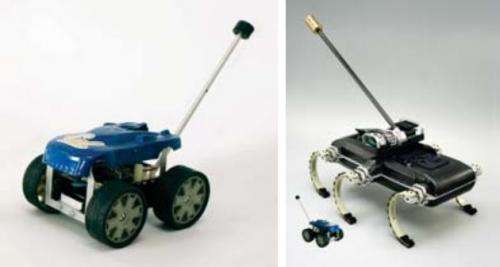August 1, 2012 report
XRL robot uses tail for easy landing on springy feet (w/ Video)

(Phys.org) -- What a difference a tail makes. Robots with tails can fly through the air while maintaining their orientation, evidence that appendages for robots can enhance performance and effectiveness. Past research from UC Berkeley explored what happens when you give a wheeled robot a controllable tail, as that used by the lizard. Now an extremely adept X-RHex Lite, or XRL for short, robot shows it can stay upright no matter how challenging the attempt is to make it do otherwise. The XRL is the result of a collaboration between UC Berkeley and the University of Pennsylvania.
The robot is based on RHex, UPenn's original hexapod robot, but the most distinguishing features of the newer version are that it is more modular, and it has an actuated tail. The common challenge has been getting mobile robots to land and stay on their feet.
To understand the roots of XRL, UPenn’s GRASP lab subsidiary, Kodlab, explains that RHex is a biologically inspired robot first thought up as part of a DARPA funded consortium. A variety of RHex platforms were subsequently developed and Kodlab stayed hot on the trail of coming up with new versions for studying biologically inspired locomotion, gait control, and sensor-based navigation. RHex platforms all include six legs.
The new XRL scores points because it can right itself in midair after being dropped at various angles. It also maintains its orientation as it is made to run off a ledge.
The XRL, at 8.1 kilograms, has six very springy legs, which act as shock absorbers. In describing their tests, the XRL team said that they compared the previously published empirical self-righting behavior of the Tailbot, a robotic car with an attached tail developed at UC Berkeley, with new, tailed XRL experiments. They said that they dropped the XRL nose-first from a 2.7 body length height and also deliberately ran it off an elevated cliff, to see it land safely on its springy legs in both cases.
The research efforts have resulted in the presentation, “Tail Assisted Dynamic Self Righting,” by Aaron M. Johnson, Thomas Libby, Evan Chang-Siu, Masayoshi Tomizuka, Robert J. Full, and D. E. Koditschek. The study was presented recently at the fifteenth international conference on Climbing and Walking Robots (CLAWAR 2012), from July 23 to 26.
Within the field of mobile robotics, scientists at the GRASP Lab point to an area of study focused on “throwing your weight around,“ using appendage inertia. Aaron Johnson and D. E. Koditschek, from the GRASP Lab, note the interesting ability of cats that, when falling, gyrate legs and tail to land on their feet. Lizards use tails to move quickly over uneven terrain. Humans use their arms for balance. Scientists, meanwhile, are focusing on how robots might use appendages for self-righting, dynamic transitions, and efficiency improvements.
© 2012 Phys.org





















